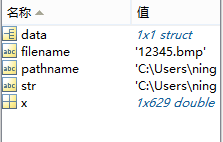MATLAB 图像打开保存
一、图片读取保存
(1)读取
clear all
[filename,pathname]=uigetfile({'*.jpg';'*.bmp';'*.gif'},'选择图片');
if isequal(filename,0)
disp('Users Selected Canceled');
else
str=[pathname filename];
im = imread(str);
imshow(im);
end


(2)保存
clear all
x=0:0.01:2*pi;
plot(x,sin(x));
[filename,pathname]=uiputfile({'*.bmp';},'保存图片');%路径和图片名
if ~isequal(filename,0)
str = [pathname filename];%路径名
data= getframe(gcf);%图片内容数据
imwrite(data.cdata,str,'bmp');
% saveas(gcf,str,'bmp');%两种方式都可以保存图片
close(gcf);
else
disp('保存失败');
end




二、灰度图和彩色图
(1)
图像中的单个点称为像素(pixel),每个像素都有一个值,称为像素值,它表示特定颜色的强度。
对于黑白图,是指每个像素的颜色用二进制的1位来表示,那末颜色只有“1”和“0”这两个值。这也就是说,要么是黑,要么是白。
对于灰度图,如果不用合成的方式来表达,可以表示为(0),(123),(255)。
如果用颜色合成的方式来表达,即它的一个像素值往往用R,G,B三个分量表示,注意,是RGB合成来表示一个像素的颜色。但要注意的 是RGB 分量必须都相等,否则就成彩色了。比如为(0,0,0)为黑,(123,123,123)为某种灰色,(255,255,255)为白。
clear all;
[filename,pathname]=uigetfile('*.*','select an image');
sample=imread([pathname filename]);%原始图
gray=rgb2gray(sample);%灰白图
bw=im2bw(sample);%黑白图
subplot(311),imshow(sample);
title('原图')
subplot(312),imshow(gray);
title('灰度图')
subplot(313),imshow(bw);
title('黑白图')


(2)rgb三分量分别表示
r=sample(:,:,1); g=sample(:,:,2); b=sample(:,:,3); subplot(131),imshow(r); subplot(132),imshow(g); subplot(133),imshow(b);

三、filter2、conv2和imfilter 平滑处理
(1)

clear all;
clear all
[filename,pathname]=uigetfile('*.*','select an image');
sample=imread([pathname filename]);
mean3Sample = filter2(fspecial('average',3),sample)/255;
mean5Sample = filter2(fspecial('average',5),sample)/255;
mean7Sample = filter2(fspecial('average',7),sample)/255;
gaussianSample = filter2(fspecial('gaussian'),sample)/255;
subplot(2,2,1);
imshow(sample); %原始图像
title('原始图像')
subplot(2,2,2);
imshow(mean3Sample); %采用均值进行平滑处理
title('平均滤波器(3)平滑处理')
subplot(2,2,3);
imshow(mean7Sample); %原始图像
title('平均滤波器(7)平滑处理')
subplot(2,2,4);
imshow(gaussianSample); %高斯滤波器进行平滑处理
title('高斯滤波器平滑处理')
conv3Sample = conv2(fspecial('average',3),sample)/255;
conv7Sample = conv2(fspecial('average',7),sample)/255;
convSample = conv2(fspecial('gaussian'),sample)/255;
figure
subplot(321),imshow(mean3Sample)
title('filter2滤波')
subplot(322),imshow(conv3Sample)
title('conv2法')
subplot(323),imshow(mean7Sample)
subplot(324),imshow(conv7Sample)
subplot(325),imshow(gaussianSample)
subplot(326),imshow(convSample)


这两个函数只能针对二维图像。滤波器本质就是加权。
(2)分别采用’prewitt’和’sobel’边缘算子对图像做边缘增强处理,并显示边缘处理后的图像
figure
%采用’prewitt’算子:
prewittSample = uint8(filter2(fspecial('prewitt'),sample));
subplot(211),imshow(prewittSample);
%采用’ sobel’算子:
sobelSample = uint8(filter2(fspecial('sobel'),sample));
subplot(212),imshow(sobelSample);

(3)采用“原图*2-平滑图像”,以及“原图+边缘处理图像”的方法锐化图像
figure %采用“原图*2-平滑图像”方法: subSample = sample.*2 - uint8(mean7Sample); subplot(211),imshow(subSample); %采用“原图+边缘处理图像”方法 addSample = sample + uint8(prewittSample); subplot(212),imshow(addSample);

(4)imfilter 彩色图像的平滑
clear all;
I = imread('lena.jpg'); %读取一张噪声图像
%提取图像的三个(R、G、B)分量图像
R = I(:,:,1);
G = I(:,:,2);
B = I(:,:,3);
%生成一个8x8的均值滤波器
w = fspecial('average',8);
fR = imfilter(R,w,'replicate');
fG = imfilter(G,w,'replicate');
fB = imfilter(B,w,'replicate');
fc_filtered = cat(3,fR,fG,fB); %三分量平滑后合为一个整体
figure
subplot(121); imshow(I);title('彩色噪声图像');
subplot(122); imshow(fc_filtered);title('彩色图像平滑处理');

clear all;
I = imread('lena.jpg'); %读取一张噪声图像
%提取图像的三个(R、G、B)分量图像
R = I(:,:,1);
G = I(:,:,2);
B = I(:,:,3);
%生成一个8x8的均值滤波器
w = fspecial('average',8);
fc_filtered = imfilter(I, w, 'replicate'); %不用rgb分量单独平滑,彩色图像的平滑函数
figure
subplot(121); imshow(I);title('彩色噪声图像');2
subplot(122); imshow(fc_filtered);title('彩色图像平滑处理');

四、锐化处理
锐化本质是边缘增强,可以采用原图加边缘增强得到
(1)
clear all
A=imread('123.png');
figure(1);
subplot(2,2,1);
imshow(A);
title('原图');
I=double(A);
h=[-1 -1 -1;-1 9 -1;-1 -1 -1];
J=conv2(I,h,'same');
K=uint8(J);
subplot(2,2,2);
imshow(J);
title('使用拉普拉斯算子锐化处理后的图(double格式)');
subplot(2,2,3);
imshow(K);
title('使用拉普拉斯算子锐化处理后的图(uint8格式)');
L=(K+A)/2;
subplot(2,2,4);
imshow(L);
title('原图+锐化');


(2)
clear all
A=imread('123.png');
figure(1);
subplot(3,2,1);
imshow(A);
title('原图');
BW=edge(A,'canny');%黑白图
subplot(3,2,2);
imshow(BW);
title('candy算子边缘检测');
K=uint8(BW);%转换格式,1白色
M=uint8(~K);%反转数值,1黑色
L_1=A-50*M;%黑色区域增强
subplot(3,2,3);
imshow(L_1);
title('黑色区域增强');
L_2=(A+K*50);%白色区域增强
subplot(3,2,4);
imshow(L_2);
title('白色区域增强');
L_3=A-50*M+50*K;
subplot(3,2,5);
imshow(L_3);
title('黑白都增强');


(3)
clear all;
I=imread('lena.jpg');
subplot(3,2,1),imshow(I);
xlabel('a)原始图像');
H=fspecial('sobel');%sobel滤波器
J=imfilter(I, H, 'replicate');%灰度值
subplot(3,2,3),imshow(J);
xlabel('Sobel锐化滤波处理');
K=I+0.32*J;%比例相加
subplot(324),imshow(K)
xlabel('Sobel锐化滤波处理+原图');
H=fspecial('laplacian');%laplacian滤波器
J=imfilter(I, H, 'replicate');%灰度值
subplot(3,2,5),imshow(J);
xlabel('laplacian锐化滤波处理');
K=I+J;%比例相加
subplot(326),imshow(K)
xlabel('laplacian锐化滤波处理+原图');

滤波器决定了是锐化或者平滑
五、RGB和HSI
(1)直方图均衡
clear all
sourcePic=imread('lena.jpg');
[m,n,o]=size(sourcePic);
grayPic=rgb2gray(sourcePic);%灰度图
subplot(321),imshow(sourcePic); title('原图')
subplot(323),imshow(grayPic); title('灰度图')
gp=zeros(1,256); %计算各灰度出现的概率 (0,255)出现的概率
for i=1:256
gp(i)=length(find(grayPic==(i-1)))/(m*n); %i灰度的概率
end
subplot(324),,bar(0:255,gp);
title('原图像直方图');
xlabel('灰度值');
ylabel('概率');
axis([0 256 0 0.02])
newGp=zeros(1,256); %计算新的各灰度出现的概率
S1=zeros(1,256);
S2=zeros(1,256);
tmp=0;
for i=1:256
tmp=tmp+gp(i);
S1(i)=tmp; %累计概率(映射到0~1)
S2(i)=round(S1(i)*256); %映射到0~255
end
%映射
for i=1:256
newGp(i)=sum(gp(find(S2==(i-1)))); %灰度值为联系
end
subplot(325),bar(0:255,newGp);
title('均衡化后的直方图');
xlabel('灰度值');
ylabel('概率');
axis([0 256 0 0.02])
newGrayPic=grayPic; %填充各像素点新的灰度值
for i=1:256
newGrayPic(find(grayPic==(i-1)))=S2(i);
end
subplot(326),imshow(newGrayPic);

clear all
sourcePic=imread('lena.jpg');
[m,n,o]=size(sourcePic);
subplot(121),imshow(sourcePic);
title('原图')
%%
grayPic=sourcePic(:,:,1);
gp=zeros(1,256); %计算各灰度出现的概率
for i=1:256
gp(i)=length(find(grayPic==(i-1)))/(m*n);
end
newGp=zeros(1,256); %计算新的各灰度出现的概率
S1=zeros(1,256);
S2=zeros(1,256);
tmp=0;
for i=1:256
tmp=tmp+gp(i);
S1(i)=tmp;
S2(i)=round(S1(i)*256);
end
for i=1:256
newGp(i)=sum(gp(find(S2==i)));
end
newGrayPic=grayPic; %填充各像素点新的灰度值
for i=1:256
newGrayPic(find(grayPic==(i-1)))=S2(i);
end
nr=newGrayPic;
%%
grayPic=sourcePic(:,:,2);
gp=zeros(1,256); %计算各灰度出现的概率
for i=1:256
gp(i)=length(find(grayPic==(i-1)))/(m*n);
end
newGp=zeros(1,256); %计算新的各灰度出现的概率
S1=zeros(1,256);
S2=zeros(1,256);
tmp=0;
for i=1:256
tmp=tmp+gp(i);
S1(i)=tmp;
S2(i)=round(S1(i)*256);
end
for i=1:256
newGp(i)=sum(gp(find(S2==i)));
end
newGrayPic=grayPic; %填充各像素点新的灰度值
for i=1:256
newGrayPic(find(grayPic==(i-1)))=S2(i);
end
ng=newGrayPic;
%%
grayPic=sourcePic(:,:,3);
gp=zeros(1,256); %计算各灰度出现的概率
for i=1:256
gp(i)=length(find(grayPic==(i-1)))/(m*n);
end
newGp=zeros(1,256); %计算新的各灰度出现的概率
S1=zeros(1,256);
S2=zeros(1,256);
tmp=0;
for i=1:256
tmp=tmp+gp(i);
S1(i)=tmp;
S2(i)=round(S1(i)*256);
end
for i=1:256
newGp(i)=sum(gp(find(S2==i)));
end
newGrayPic=grayPic; %填充各像素点新的灰度值
for i=1:256
newGrayPic(find(grayPic==(i-1)))=S2(i);
end
nb=newGrayPic;
%%
res=cat(3,nr,ng,nb);
subplot(122),imshow(res);
title('均衡化后的图像')

(2)hsi(色调、饱和度、亮度)和hsv(色调(H),饱和度(S),明度(V))。
clear all
% hsi = rgb2hsi(rgb)把一幅RGB图像转换为HSI图像,
% 输入图像是一个彩色像素的M×N×3的数组,
% 其中每一个彩色像素都在特定空间位置的彩色图像中对应红、绿、蓝三个分量。
% 假如所有的RGB分量是均衡的,那么HSI转换就是未定义的。
% 输入图像可能是double(取值范围是[0, 1]),uint8或 uint16。
%
% 输出HSI图像是double,
% 其中hsi(:, :, 1)是色度分量,它的范围是除以2*pi后的[0, 1];
% hsi(:, :, 2)是饱和度分量,范围是[0, 1];
% hsi(:, :, 3)是亮度分量,范围是[0, 1]。
% 抽取图像分量
rgb=imread('lena.jpg');
rgb = im2double(rgb);
r = rgb(:, :, 1);
g = rgb(:, :, 2);
b = rgb(:, :, 3);
% 执行转换方程
num = 0.5*((r - g) + (r - b));
den = sqrt((r - g).^2 + (r - b).*(g - b));
theta = acos(num./(den + eps)); %防止除数为0
H = theta;
H(b > g) = 2*pi - H(b > g);
H = H/(2*pi);
num = min(min(r, g), b);
den = r + g + b;
den(den == 0) = eps; %防止除数为0
S = 1 - 3.* num./den;
H(S == 0) = 0;
I = (r + g + b)/3;
% 将3个分量联合成为一个HSI图像
hsi = cat(3, H, S, I);
subplot(121),imshow(hsi)
title('hsi图像')
subplot(122),imshow(rgb2hsv(rgb))%自带函数
title('hsv图形')




